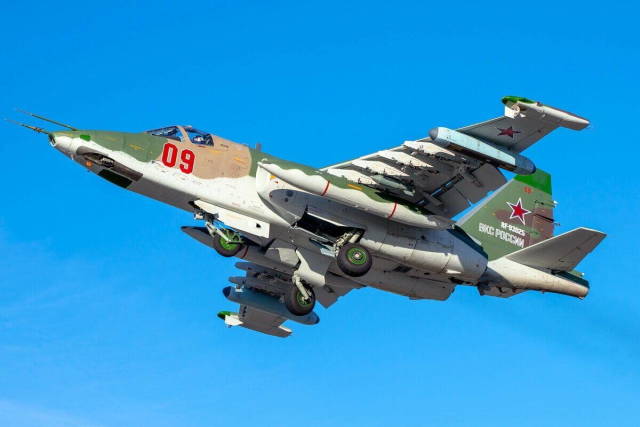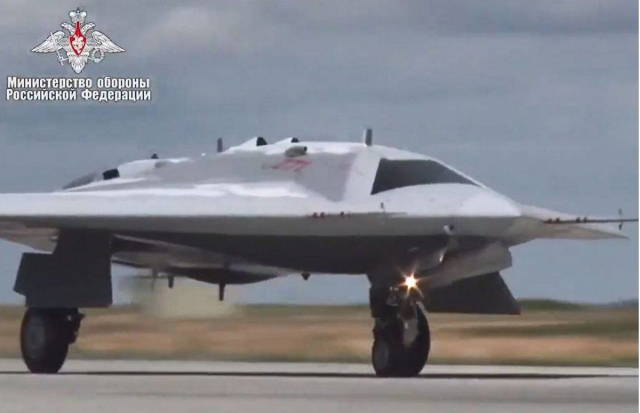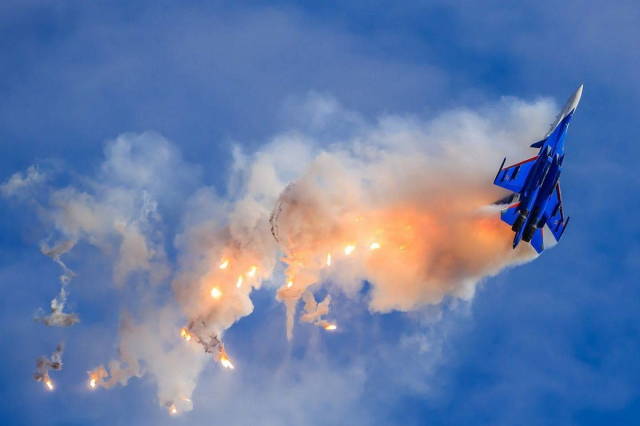We continue ( part I ) the publication of the reflections of the experts of the British publishing group Shephardmedia on the current state of the Russian Air Force. [Explanations of IVi are given in square brackets]
Attack aircraft of the Russian Air Force
Fighter-bombers and attack aircraft are another important part of tactical aviation and are actively used during Russian military operations in Syria. The Russian Air Force operates three types of aircraft of this class: Su-24 and Su-34 front-line bombers, as well as Su-25 attack aircraft.
The most advanced of them is the Su-34 – another variant of the Su-27 [according to the NATO codification Flanker-B – "Flanker-B"]. Compared to the basic "Flanker", the Su-34 has a heavily redesigned layout with a pilot and an armament operator sitting side by side, a large central tail boom housing an auxiliary power plant, a braking parachute, a small rear-facing radar and an additional fuel tank.

Su-34 bomber
It also has increased survivability and supports a wide range of guided and unguided weapons. Avionics includes a radar with a passive scanning antenna array (PESA), an integrated laser/television guidance device and a jamming system.
Serial deliveries of the Su-34 began in 2006, and by the end of 2020, the Russian Air Force received 131 aircraft of this model. In 2020, a contract was signed for the supply of 24 more bombers by 2023. The first contract for an upgraded version of the Su-34M bomber is also being discussed. It is known that as part of the Sych program, they will receive new multi-purpose guidance units.
Soviet Su-24M bombers are gradually being withdrawn from the Russian Air Force, despite the fact that some of them have been upgraded to the Su-24M2 standard, and others have received the SVP-24 Hephaestus sighting and navigation system. It can be reasonably predicted that by 2030 all aircraft of this type will be written off. The established production of the Su-34 will make this process smooth.

Su-25 CM3 attack aircraft
As for the aging Su-25 attack aircraft, there is no decent alternative to it yet. These simple machines are very effective and tenacious when used for direct air support of troops, and for this reason they have been subject to modernization since 2006. At that time, the aircraft were upgraded to the Su-25SM standard, with an emphasis on the installation of the PrNK-25SM Bars sighting and navigation system and the expansion of the range of guided weapons.
Since 2016, aircraft have been upgraded to the Su-25SM3 standard. The attack aircraft received a new SALT-25 sighting and navigation system, the Vitebsk-25 electronic warfare system, SVP-24-25 sighting and navigation systems, etc. Despite plans to modernize the entire existing fleet of about 200 Su-25s, there is no replacement for the aircraft in the foreseeable future.
Unmanned Awakening
Another long-term goal of increasing the potential of the Russian Air Force is the development of heavy UAVs and the use of the interaction potential of crewed and unmanned platforms. At the same time, several projects are under implementation.
The first and currently the most advanced UAV is the Sukhoi S-70 Hunter . It weighs 20 tons, can carry up to 2 tons of weapons and uses one AL-41F1 engine. Many details are common with the Su-57 fighter. The Hunter probably has a PESA or AESA radar and can exchange data with manned aircraft.
This capability was tested at least once in 2019: the Hunter shared radar data, and the Su-57 was able to launch a missile at a target without using its own radar. There are plans to strengthen the integration of the Su-57 and S-70 and even create shelves that include both types.

Russian S-70 Hunter UAV before takeoff
Another unfinished project is the Thunder UAV, which the Kronstadt company presented at the Army 2020 exhibition. "Thunder" is very similar to the American XQ-58 Valkyrie and the Australian Loyal Wingman.
For a drone, the device has large dimensions and weight. Its length is 13.8 m, wingspan is 10 m, take-off weight is 7 tons, of which up to 2 tons is the payload. According to these parameters, the "Thunder" is comparable to the fighters of the second and third generation. It develops a maximum speed of up to 1000 km/h, has a cruising speed of 800 km/h and a combat range of up to 700 km. The company has not yet announced the timing of the first flight, and a full-size mock-up was presented to the public.
The layout of the UAV "Thunder"
This is followed by a version without a Checkmate fighter crew ["Checkmate", more details in Part I ], announced at the Dubai Air Show in November 2021. According to the United Aircraft Corporation, the aircraft will be used as a platform for collaboration with and without the crew. At this stage, such statements should be taken with a degree of skepticism: there is nothing ready in this project, apart from simple 3D graphics in a marketing video.
The latest and, perhaps, the most remote manned-unmanned joint project is a promising multifunctional UAV, which the MiG Corporation presented in the form of a small-scale sample. This UAV is similar to the existing S-70 "Hunter" and is based on the earlier project "Stingray". A full-scale mock-up was shown at MAKS-2007, but the program was suspended in 2012.
Trying to keep up
The Russian Air Force has become much more capable, having received about 460 new combat aircraft over the past 15 years. Among them are 12 Su-27SM(3), 134 Su-30SM/M2, 98 Su-35S, one Su-57, 131 Su-34, 50 MiG-29SMT/UB, 24 MiG-29K/KUB and four MiG-35. In addition, many obsolete aircraft have been upgraded.
It is noteworthy that most of the new aircraft belong to the "4+" generation and above, which allows Russia to act effectively in any local and regional conflicts. This is confirmed by the Syrian campaign, where the Russian Air Force operated much more successfully than in August 2008.
However, the implementation of a number of promising projects is still difficult. The development and production schedules of the Su-57 are often postponed, since the aircraft is still not in optimal condition, and the timing of the completion of the new engine "Product 30" is still unclear. The long-term plans of the Ministry of Defense for the purchase of fifth-generation fighters, which are noticeably more expensive than the upgraded Su-27, are also unclear. At the same time, the Russian Armed Forces are rapidly disposing of Soviet-era aircraft.
As a result, if in the early 2000s there were at least 2,000 combat aircraft in Russia, today their number barely exceeds 1,200, even taking into account new deliveries. It will obviously not be possible to replace the decommissioned aircraft exclusively with the Su-57, so the purchases of "Flankers" will probably continue at least until 2030.
The appearance of a cheaper Su-75 may accelerate the curtailment of purchases of fourth-generation fighters closer to 2030. It should also be noted that Russia's aviation capabilities are completely insufficient for a global confrontation with NATO, neither in quantity nor in quality. Apparently, such a task is not set for the Russian Armed Forces.
The development of high-tech pilotless groups based on the Su-57 or Su-35S paired with the S-70 Hunter and/or Thunder will help the Russian Air Force to operate even more successfully in local conflicts, almost completely eliminating the risks of personnel losses. However, these projects are unlikely to reach production status in the near future, and their success is not guaranteed.
According to the materials of the resource shephardmedia.com
The materials of the article contain exclusively the author's estimates and do not reflect the position of the editorial board of IVi

